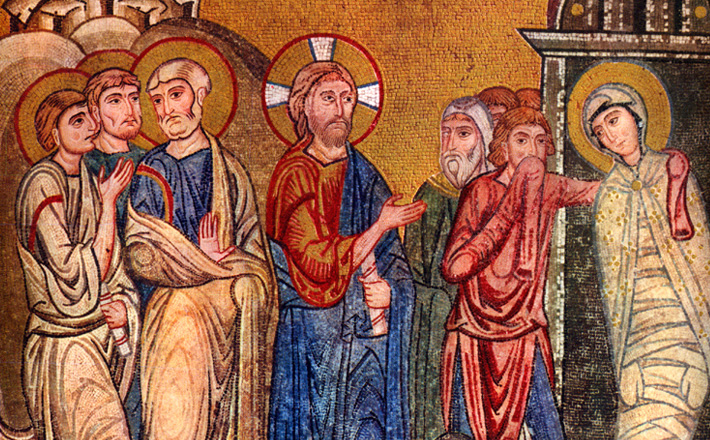Commentary on John 11:1-45
In this chapter, which lies at the rhetorical and theological center of the gospel of John, we have yet another conversation of Jesus with a couple of women, two sisters, Mary and Martha.
We also have an example of the use of rhetoric to convey theological meaning.
Placement of John 11 in the layout of the Gospel
John 11 is located precisely at the center of the Gospel: 10 chapters precede it and 10 chapters follow it.
The centrality of this chapter in relationship to the whole document has been recognized by many scholars, though almost all of them pair it with John 10. David Barr’s outline, in his book New Testament Story,1 is a typical example:
Testimony to the true identity of Jesus……………………………………………………1
The glory of God revealed in signs………………………………………………2-4
The union of Jesus with God in action…………………………………5-10
The ultimate sign……………………………………………..11-12
The union of Jesus with God in Word…………………………….….13-17
Jesus is glorified in his death…………………………………………………18-20
Testimony of the community to the truth………………………………………………..21
Barr says that the underlying theme of the action in John 1-12 is the descent of the Word into the world (1:9). Jesus’ ministry is public and the main topics are life and light, appearing 82 times as opposed to only 6 times afterwards.
In John 13-17 Jesus’ ministry shifts from the crowds to the disciples. There are no more signs and the topic is love (31 times, but only 6 times earlier). Jesus is now oriented towards the Father (13:1). Barr thinks that there is a connection between the form or John’s narrative and the basic Johannine worldview, namely, a dualism, a going out from the Father (John 1-12) and a return to the Father (John 13-20), a coming down and a going up.
The raising of Lazarus in John 11 stands as a hinge between Jesus’ public ministry and his private ministry to the disciples. It represents a climax to Jesus’ earlier actions (this is the ultimate sign, the last in a series of 7) and a foreshadowing of his own death and resurrection. It is also a moment of profound irony because the one who is the resurrection and the life, the light of the world, starts to walk the path of self-renunciation that will ultimately lead him through the narrow and dark alleys of death. But at the same time, Lazarus’ raising foreshadows Jesus’ own resurrection and glorification.
Relationship between text and praxis
One of the reasons why the Gospels were written was to motivate the believers to the imitatio Jesu (the imitation of Christ). I am convinced that discipleship is better exemplified by Jesus than it is by the disciples themselves.2 Thus, Jesus’ paradoxical living is an example of the believers’ paradoxical existence.
If John 11 falls at the center of the gospel, and if there is any relationship between form and message, between rhetoric and theology, between the social and the literary, then this strategic positioning should have some theological implications. It might be saying something about the community’s reality. If the blind man of John 9 symbolizes the community in its cultural and religious estrangement from the synagogue, then Lazarus, which means “God helps,” could also represent the Johannine community which had been relegated by the religious authorities to the grave of cultural marginalization, a dead body without access to participation in the body politic.
Lazarus’ resuscitation, then, stands for the community’s daring affirmation that it is belief in Jesus as Messiah and Son of God, the Logos of God, that enables them to claim their right to abundant life, that is, to full participation in the life of God’s reign. Therefore, the center of the gospel speaks of the belief of the community that despite their predicament they can still find true life and real liberation in their communion with Jesus, the true vine.
Placement of Martha’s confession in the layout of John 11
John 11 has a center of its own, with a related theological implication.
John 11 has 57 verses, but the story is told in verses 1-54. Verse 55 starts a new section that serves as an introduction to Mary’s anointing in John 12. This new section is marked by the catchword Passover in 11:55 and 12:1 linking both chapters. Its rhetorical center lies at verse 27.
And what do we find there? Martha’s confession of faith in Jesus as the Messiah and Son of God, which is precisely the purpose of the gospel as expressed in 20:31. Therefore, this is not only the center of John 11, but also the rhetorical and theological center of the entire gospel. It constitutes its main theological statement and it is verbalized by a woman!
In John 1 we have a similar confession, though not as developed as Martha’s, put in the lips of Nathanael, “Rabbi, you are the Son of God! You are the King of Israel!” (verse 49) to which Jesus replies, “Do you believe because I told you that I saw you under the fig tree? You will see greater things than these” (verse 50). This belief in Jesus as Messiah and Son of God is placed at the beginning, middle, and end of the gospel, which bespeaks of a strategic rhetorical positioning that is meant to convey meaning by its mere presence.
Implications for preaching
Oppressed and marginalized communities find that their commitment to a life of discipleship will give them the hope that mainline society denies them. In their struggles to gain recognition as equal human beings, African Americans, Latinas/os, Asians, Native Americans, LGBT communities, immigrants, and refugees, etc., proclaim with their lives the power of the resurrection giving new life to culturally dead bodies.
Despite the gospel’s general tendency to use the words of those who engage Jesus in conversation as foils to Jesus’ own words, to make clear that only his words should be listened to, still on several occasions his interlocutors make important theological points. When that happens, it is usually women (the Samaritan woman in John 4, Mary and Martha in John 11). As a matter of fact, women make more and better theological statements in the Gospel of John than their male counterparts. How could this information affect your preaching when using John as a text? How would that help bring about the equality women in the church are still fighting for?
Jesus’ death and resurrection are anticipated in the narrative by Lazarus’ death and raising. His prophetic praxis leading to death is foreshadowed in Mary’s anointing in John 12. Therefore, we see Jesus as part of a community of faith who teaches him, through word and symbolic action, the fate of discipleship, something he is about to experience in Jerusalem.
Notes:
1 David Barr’s New Testament Story. Wadsworth, 2002.
2 See here my book Jesus, Disciple of the Kingdom: Mark’s Christology for a Community in Crisis. Eugene, Ore.: Pickwick Publications, 2014.


April 2, 2017